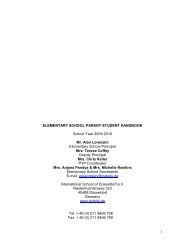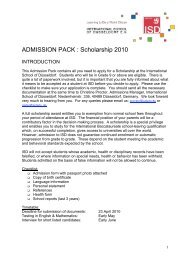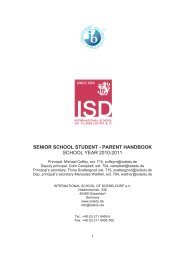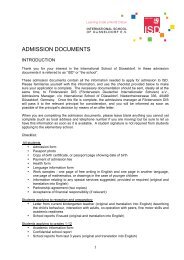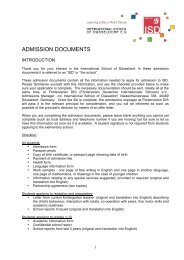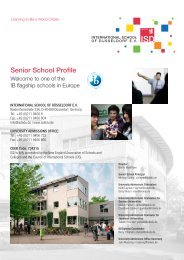Curriculum Handbook 2012-2013 Grades 11-12 - International ...
Curriculum Handbook 2012-2013 Grades 11-12 - International ...
Curriculum Handbook 2012-2013 Grades 11-12 - International ...
You also want an ePaper? Increase the reach of your titles
YUMPU automatically turns print PDFs into web optimized ePapers that Google loves.
ISD Diploma<br />
In grades nine and ten the MYP overlaps with the requirements for the ISD diploma and<br />
leads into the IB diploma in grades eleven and twelve.<br />
Normally, a 9th grader is scheduled for ten courses, a tenth grader for nine or ten.<br />
To be awarded the ISD diploma a student must have<br />
• completed four years of education in grades 9-<strong>12</strong> or their equivalents.<br />
• successfully completed ninth and tenth grades (at ISD this normally means having<br />
followed years 4 and 5 of the IBMYP, including at least three electives) with no more<br />
than two final academic achievement grades below 3 in either year.<br />
• earned a minimum total of 40 points over grades <strong>11</strong> and <strong>12</strong>, with no more than four<br />
final academic achievement grades below 3, of which no more than two may be earned<br />
in <strong>12</strong> th grade.<br />
• successfully completed the C&S/CAS programme during each year of attendance (G9-<br />
<strong>12</strong>) at ISD. 1<br />
In addition each student should have:<br />
• taken at least one year of mainstream English<br />
• taken three consecutive years of the same foreign language<br />
• studied German to a minimum competency level equivalent to ISD's "Advanced<br />
German" (normally three years).<br />
There may, under exceptional circumstances, be students for whom these requirements<br />
might not be appropriate. In these cases the principal will determine whether or not the<br />
student has met the conditions under which an ISD diploma can still be awarded.<br />
VISUAL ARTS <br />
The Visual Arts at ISD offers all students a wide range of study and the opportunity<br />
to explore and express ideas and feelings in the studio. Value is given to the<br />
development of technical skill, including drawing and composition. The study helps<br />
develop visual literacy, visual communication skills and creativity, so vital in the<br />
visual world of today. In an international environment, the study of the visual arts<br />
helps students develop a richer understanding of their own culture and fosters<br />
sensitivity towards cultural diversity, partly through critical studies and the study of<br />
the history of art. Learning through the Visual Arts is both challenging and<br />
enjoyable. It enhances learning in other subjects and is learning for life.<br />
IB DP Visual Arts SL/HL 1 and 2, <strong>Grades</strong> <strong>11</strong> & <strong>12</strong><br />
The <strong>International</strong> Baccalaureate Visual Arts is offered as a Group 6 subject. It is a<br />
two- year course and consisting of two components: studio work (A 60% or B 40%)<br />
and investigation workbook (A 40% or B 60%) i.e. the students can choose whether<br />
the emphasis lies with studio work (A) or the investigation workbook (B).<br />
From a common starting point students have the opportunity to develop individual<br />
and personal work in different media. Students also choose personally relevant<br />
themes for research both in the studio and in their investigation workbooks. Visits to<br />
local art museums and exhibitions will be arranged. In addition, there is an extended<br />
field trip to a major art city.<br />
The course concludes with an examination of the studio work by a visiting examiner<br />
and the investigation workbooks are examined by the teacher (A) the reverse for (B).<br />
All examination materials are subject to moderation by senior examiners.<br />
IB DIPLOMA<br />
The <strong>International</strong> Baccalaureate Diploma is offered as a supplement to the ISD diploma.<br />
The IB diploma curriculum consists of a comprehensive and rigorous two-year programme,<br />
normally undertaken in the <strong>11</strong>th & <strong>12</strong>th grades (in exceptional cases in grades <strong>12</strong> and 13).<br />
Based on the educational pattern of no single country, it is a deliberate compromise<br />
between the specialization required in some countries and the breadth and depth preferred<br />
in others. Since its inception in the late 1960's, the IB diploma has become a symbol of<br />
academic integrity and intellectual promise, and is accepted widely throughout the world as<br />
a university entrance qualification.<br />
IB diploma candidates must pass examinations in six areas, including Language A (best or<br />
native language); an additional language; individuals and societies; experimental sciences;<br />
mathematics; and a sixth subject, an elective. Of the six examinations, three must be taken<br />
at the higher level and three at the standard level.<br />
Other requirements are<br />
• The completion of the "Theory of Knowledge" course (the role of language and thought;<br />
logic; ways of knowing and areas of knowledge, e.g. mathematics, natural sciences,<br />
human sciences, history, and value judgments, e.g. moral, political and aesthetic<br />
judgments);<br />
1 This requirement only becomes operative when a C&S/CAS programme has been set up in grades 6-<strong>12</strong>.<br />
6<br />
35



